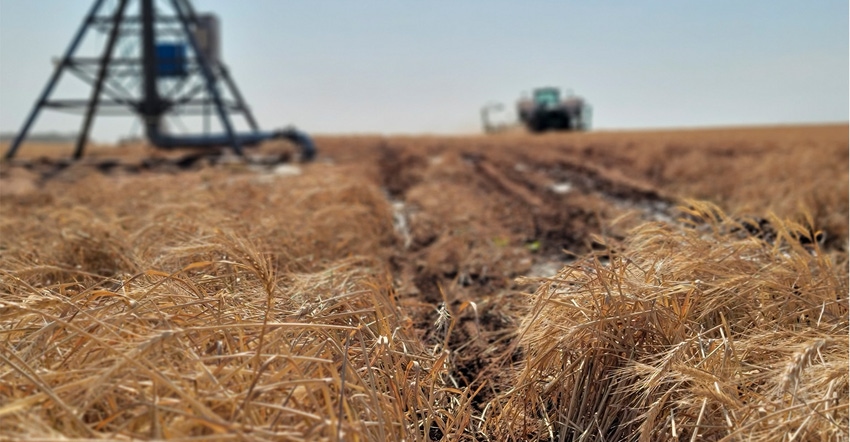
Adopting cropping practices designed to sequester carbon offers benefits regardless of a carbon market, which currently is uncertain.
“Adopting these practices solely for the carbon market may not be beneficial now,” said Texas A&M AgriLife Associate Professor Katie Lewis, Lubbock.
But carbon farming practices will improve soil health, especially on poorer, sandier soils, she said.
“Sandier soil with poor soil structure, compared to heavier textured soil, is more erodible and is less stable,” Lewis explained.
She said practices such as rotating higher biomass crops with cotton and planting cover crops will improve soil structure, cut erosion losses, and reduce evaporative losses.
Best option for sequestration
As with most production and management practices, best options for carbon sequestration vary from farm to farm. “The bigger picture is dependent on the characteristics of the farm,” Lewis said. “Soil texture plays into what crop and what practice will be most beneficial.”
Lewis said research plots on the Helm Farm, near Halfway, Texas, north of Lubbock, feature heavy-textured soil and are better suited to cover crops versus a wheat/cotton rotation.
Plots in Lamesa with sandier soil do better with a cotton, wheat, fallow rotation.
“Irrigation capacity also affects best management practices,” Lewis said.
Advantages of cover crops and rotation include added residue and organic matter, which enhance microbial activity. “Residue from a cover crop or rotation crop stimulates microbial activity and promotes carbon sequestration.
“These practices also improve chemical properties such as cation exchange capacity. We see increased nutrient availability and possibly less leaching losses with increased cation exchange capacity,” Lewis said.
Cover crops economics
Economics can be a challenge. “In some cases, and with certain practices, we see a decrease in cotton lint yield. Dryland production is risky with a cover crop because of our unpredictable rainfall. But we also can see reduced lint yield with some of these practices in irrigated fields.”
Cover crops offer no significant economic benefit and the more expensive cover crop mixes might be cost-prohibitive in some situations.
“We do achieve environmental benefits. Many farmers plant a cover crop to limit sand fighting. But cover crops may be hard to justify in dryland situations.”
She also noted that rotation options could be limited by availability of grain elevators or other market outlets.
Lewis recommends producers interested in adding carbon sequestering practices to their farms should start small.
“Consider irrigation capacity and soil texture. I lean toward rotation over cover crops. But farmers who rent land also have to consider landlords’ wishes. Some might not want to take cotton off a field for a year.”
She said producers should consider all the factors that affect crop management changes. “Then start simple. If a farmer wants to add a cover crop, start with a single cover, wheat, or rye, and maybe not drill across the entire farm. We just don’t know what the outcome will be on a specific piece of land.
“Also, reach out to other farmers who have used cover crops. Check with Extension. They have good information in Texas and across the U.S.”
Key practices
Lewis said key practices to consider when considering carbon sequestration include cover crops, rotation, reduced tillage, and, in some cases with adequate water, double-cropping.
Despite the challenges, Lewis said interest in adopting these practices seem to be increasing. “Every year I see more winter and in some cases summer cover crops. The number of acres planted to cover has increased, based on my observations.” She said she has no precise numbers on additional acreage in cover crops, rotation, or other conservation management practices, but the increase seems to be consistent.
Lewis said she and AgriLife Professor Wayne Keeling have observed this year that cotton planted into a cover crop or in a cotton, wheat, or sorghum rotation looked better than conventionally tilled fields.
“Cotton planted in a cover crop or in rotation, if it got established, seems to be developing at a faster pace than cotton that experienced wind and sand damage,” she said.
She added that this spring was a risky one to plant cotton in cover because of limited rainfall.
“Some farmers also plant wheat or rye only in the furrows, not on the bed, to prevent wind and sand damage. That is less expensive.”
Lewis said the carbon market is “quiet now. From mid-2021 until the start of 2022, we seemed to be hearing about the carbon market constantly.”
She said things calmed down following the initial announcements of USDA carbon funding opportunities.
“Meanwhile, NRCS offers some new programs for conservation practices that tie into carbon sequestration.”
The current carbon market remains a question mark, Lewis said. And the economics of carbon sequestration practices might not always pan out, but the environmental benefits are real and offer opportunities to conserve and improve an essential resource.
Read more about:
Carbon MarketAbout the Author(s)
You May Also Like






